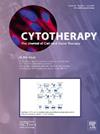Human neural stem cells transplanted during the sequelae phase alleviate motor deficits in a rat model of cerebral palsy
IF 3.2
3区 医学
Q2 BIOTECHNOLOGY & APPLIED MICROBIOLOGY
引用次数: 0
Abstract
Aims
Cerebral palsy (CP) is the most common physical disability in children, yet lacks an ideal animal model or effective treatment. This study aimed to develop a reliable CP model in neonatal rats and explore the effectiveness and underlying mechanisms of human neural stem cells (hNSCs) transplantation during the sequelae phase of CP.
Methods
Vasoconstrictor endothelin-1 (ET-1) was administered intracranially to the motor cortex and striatum of rats on postnatal day 5 to establish a CP model. hNSCs (5 × 105/5 μL) pretreated with hypoxia (5% O2 for 24 h) were transplanted near the infarct 3 weeks after ET-1 injury (the sequelae phase). The distribution and differentiation of hNSCs were observed after transplantation. Changes in neurotrophic factors, neurogenesis, angiogenesis, axonal plasticity, and motor function were analyzed.
Results
Neurobehavioral tests showed poor muscle strength and postural control in young ET-1 rats. Motor deficits of the left forelimb and gait abnormalities persisted into adulthood. Histopathological findings and MRI indicated the atrophy of the cortex, striatum, and adjacent corpus callosum in ET-1 rats. At 56 days after transplantation, hNSCs were widely distributed in the ipsilateral hemisphere, and differentiated into neurons, oligodendrocytes and astrocytes. Transplantation of hNSCs increased BDNF and VEGF expression, EdU+ cell number in the SVZ area, RECA-1+ vessel density and GAP-43 intensity around the lesion in ET-1 rats. The cylinder test revealed a significant increase in the left forelimb motor function from 28 days after transplantation, and the staircase and CatWalk tests showed improvements in fine motor function and gait parameters.
Conclusions
Intracerebral injection of ET-1 modelled key functional and histopathological features of CP. hNSCs transplanted during the sequelae phase of CP resulted in long-term improvement in motor performance, possibly attributed to its capacity to stimulate neurotrophic factors, facilitate neurogenesis, angiogenesis, and promote axonal plasticity.
在后遗症期移植人类神经干细胞可减轻脑瘫大鼠模型的运动障碍
目的脑性瘫痪(CP)是儿童最常见的肢体残疾,但缺乏理想的动物模型或有效的治疗方法。本研究旨在建立一种可靠的新生大鼠脑瘫模型,并探讨在脑瘫后遗症期移植人神经干细胞(hNSCs)的有效性及其内在机制。在ET-1损伤3周后(后遗症期),将预处理为缺氧(5%氧气,24小时)的hNSCs(5 × 105/5 μL)移植到梗死区附近。移植后观察了 hNSCs 的分布和分化情况。结果神经行为测试表明,幼年 ET-1 大鼠的肌力和姿势控制能力较差。左前肢的运动障碍和步态异常一直持续到成年。组织病理学结果和核磁共振成像显示,ET-1大鼠的大脑皮层、纹状体和邻近的胼胝体萎缩。移植后56天,hNSCs广泛分布于同侧大脑半球,并分化为神经元、少突胶质细胞和星形胶质细胞。移植hNSCs后,ET-1大鼠病变周围的BDNF和VEGF表达、SVZ区EdU+细胞数量、RECA-1+血管密度和GAP-43强度均有所增加。结论脑内注射 ET-1 模拟了 CP 的主要功能和组织病理学特征。在 CP 后遗症期移植 hNSCs 可长期改善大鼠的运动能力,这可能是由于 hNSCs 能够刺激神经营养因子、促进神经发生、血管生成和轴突可塑性。
本文章由计算机程序翻译,如有差异,请以英文原文为准。
求助全文
约1分钟内获得全文
求助全文
来源期刊

Cytotherapy
医学-生物工程与应用微生物
CiteScore
6.30
自引率
4.40%
发文量
683
审稿时长
49 days
期刊介绍:
The journal brings readers the latest developments in the fast moving field of cellular therapy in man. This includes cell therapy for cancer, immune disorders, inherited diseases, tissue repair and regenerative medicine. The journal covers the science, translational development and treatment with variety of cell types including hematopoietic stem cells, immune cells (dendritic cells, NK, cells, T cells, antigen presenting cells) mesenchymal stromal cells, adipose cells, nerve, muscle, vascular and endothelial cells, and induced pluripotential stem cells. We also welcome manuscripts on subcellular derivatives such as exosomes. A specific focus is on translational research that brings cell therapy to the clinic. Cytotherapy publishes original papers, reviews, position papers editorials, commentaries and letters to the editor. We welcome "Protocols in Cytotherapy" bringing standard operating procedure for production specific cell types for clinical use within the reach of the readership.
 求助内容:
求助内容: 应助结果提醒方式:
应助结果提醒方式:


